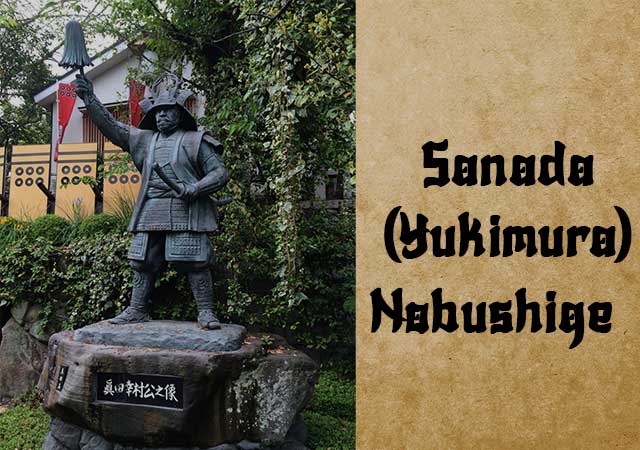
Sanada Nobushige, also known as Yukimura, emerged as one of the most illustrious samurai of the Sengoku Period. Born as the second son of Sanada Masayuki and younger sibling to Sanada Nobuyuki, he was originally named Nobushige and acquired the moniker "Yukimura" only through later Edo period tales. Renowned as the "Crimson Demon of War" due to his blood-red banners and armor, he earned titles such as "Japan’s Greatest Warrior" and even the "Last Sengoku Hero" among his contemporaries.
As a youth, he was sent by his father as a hostage to the Uesugi clan, later returning to serve Toyotomi Hideyoshi directly. Nobushige married Aki-hime, the daughter of Otani Yoshitsugu, who was adopted by Toyotomi Hideyoshi. Throughout his life, Nobushige displayed remarkable bravery and strategic prowess in various battles, notably defending Ueda Castle against multiple Tokugawa sieges. Despite being vastly outnumbered, he valiantly held off Tokugawa forces, earning admiration and respect.
Following the Battle of Sekigahara, where the Sanada family was divided between the Western and Tokugawa forces, Nobushige and his father were stripped of their domain and exiled to Mt. Koya. Despite this setback, Nobushige continued to resist the Tokugawa, participating in the Winter Siege and Summer Campaign of Osaka Castle. He constructed the formidable Sanada Maru, a crescent-shaped fortress, and led fierce defenses against overwhelming Tokugawa forces.
Tragically, during the Summer Siege of Osaka, Nobushige, exhausted from relentless battles, faced defeat. Despite his valiant efforts, he succumbed to his injuries under a pine tree in the grounds of the Yasui Shrine, allowing a Tokugawa samurai named Nishio Nizaemon to claim his head. Nobushige's death dealt a significant blow to the morale of the Osaka troops, marking the end of an era. Today, a statue commemorates his valiant spirit beneath the solemn shade of the shrine's pine tree.
See also
-
Yamagata Masakage

Masakage was one of Takeda Shingen’s most loyal and capable commanders. He was included in the famous list of the “Twenty-Four Generals of Takeda Shingen” and also belonged to the inner circle of four especially trusted warlords known as the Shitennō.
-
Yagyu Munenori

Yagyū Munenori began his service under Tokugawa Ieyasu while his father, Yagyū Muneyoshi, was still at his side. In 1600, Munenori took part in the decisive Battle of Sekigahara. As early as 1601, he was appointed a kenjutsu instructor to Tokugawa Hidetada, Ieyasu’s son, who later became the second shogun of the Tokugawa clan.
-
Yagyu Muneyoshi

A samurai from Yamato Province, he was born into a family that had been defeated in its struggle against the Tsutsui clan. Muneyoshi first took part in battle at the age of sixteen. Due to circumstances beyond his control, he was forced to enter the service of the Tsutsui house and later served Miyoshi Tōkei. He subsequently came under the command of Matsunaga Hisahide and in time became a vassal first of Oda and later of Toyotomi.
-
Endo Naozune

Naozune served under Azai Nagamasa and was one of the clan’s leading vassals, renowned for his bravery and determination. He accompanied Nagamasa during his first meeting with Oda Nobunaga and at that time asked for permission to kill Nobunaga, fearing him as an extremely dangerous man; however, Nagamasa did not grant this request.
-
Hosokawa Sumimoto

Sumimoto came from the Hosokawa clan: he was the biological son of Hosokawa Yoshiharu and at the same time the adopted son of Hosokawa Masamoto, the heir of Hosokawa Katsumoto, one of the principal instigators of the Ōnin War. Masamoto was homosexual, never married, and had no children of his own. At first he adopted Sumiyuki, a scion of the aristocratic Kujō family, but this choice provoked dissatisfaction and sharp criticism from the senior vassals of the Hosokawa house. As a result, Masamoto changed his decision and proclaimed Sumimoto as his heir, a representative of a collateral branch of the Hosokawa clan that had long been based in Awa Province on the island of Shikoku. Almost immediately after this, the boy became entangled in a complex and bitter web of political intrigue.
-
Honda Masanobu

Masanobu initially belonged to the retinue of Tokugawa Ieyasu, but later entered the service of Sakai Shōgen, a daimyo and priest from Ueno. This shift automatically made him an enemy of Ieyasu, who was engaged in conflict with the Ikkō-ikki movement in Mikawa Province. After the Ikkō-ikki were defeated in 1564, Masanobu was forced to flee, but in time he returned and once again entered Ieyasu’s service. He did not gain fame as a military commander due to a wound sustained in his youth; nevertheless, over the following fifty years he consistently remained loyal to Ieyasu.
-
Honda Masazumi

Masazumi was the eldest son of Honda Masanobu. From a young age, he served Tokugawa Ieyasu alongside his father, taking part in the affairs of the Tokugawa house and gradually gaining experience in both military and administrative matters. At the decisive Battle of Sekigahara in 1600, Masazumi was part of the core Tokugawa forces, a clear sign of the high level of trust Ieyasu placed in him. After the campaign ended, he was given a highly sensitive assignment—serving in the guard of the defeated Ishida Mitsunari, one of Tokugawa’s principal enemies—an obligation that required exceptional reliability and caution.
-
Hojo Shigetoki

Hōjō Shigetoki, the third son of Hōjō Yoshitoki, was still very young—only five years old—when his grandfather Tokimasa became the first member of the Hōjō clan to assume the position of shogunal regent.

